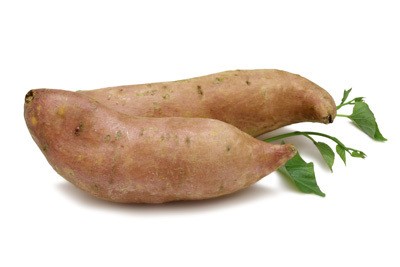
Although most often thought of as a food for the holidays, sweet potatoes are becoming more and more popular as a garden crop. And why not? This warm season crop is easy-to-grow, contains a high amount of vitamins and a relatively low amount of calories, and tastes delicious!
Some confusion exists over the difference between sweet potatoes and yams because the terms are often used interchangeably (this tends to come up a lot during the holidays). Related to the morning glory, the sweet potato is a tender tropical vine. The part that we eat (the potato) is actually a root and not a tuber (as with white potatoes). There are two basic types of sweet potatoes. One has a light-colored flesh, which is dry, mealy and less sweet tasting (like white potatoes). The other type has a dark orange, moist and sweet-tasting flesh.
All of the so-called "yams" grown in the United States are actually sweet potatoes. The U.S. Department of Agriculture now requires labels with the term "yam" to be accompanied by the term "sweet potato", if they are in fact really sweet potatoes. True yams are much harder to find in many U.S. grocery stores.
Sweet potatoes typically need a long, warm growing season of at least 100 to 120 days to reach maturity. Although usually thought of as a southern crop, many northern gardeners (north of Zone 6) have achieved success by starting slips indoors, and growing cultivars like "Georgia Jet", "Beauregard", or "Centennial", which can mature in as early as 90 days. If you garden in the north, you might also try warming up spring soil temperatures by covering your garden with black plastic for a few weeks before planting.
Sweet potatoes are grown from slips (rooted shoots) or sprouted cuttings. They are not grown from seeds or by using grocery store sweet potatoes. Slips can be purchased from mail-order suppliers or found at local nurseries. If you have a sweet potatoes from your garden (or a neighbor's) that has survived winter indoors, you can start your own slips. About 12 weeks before your last expected frost date, submerge the bottom third of the potato into a jar filled with water (Use toothpicks to support the potato on the rim of the jar). Place the jar in a sunny spot. In a few weeks sprouts will start to form on the potato. Once these reach 5-6 inches long, carefully remove them from the potato and stick them in damp sand to root. When garden soil temperatures warm to 55-65 degrees F, harden off the seedlings and transplant them into the garden.
Site: Full sun. Plant them where sweet potatoes have not been grown for at least 2 years.
Soil: Not too fussy. Loose, nutrient-rich soil with a pH of 5.5 to 6.5 is ideal. Once established, plants are drought tolerant. The "Centennial" variety is said to be tolerant of clay soils.
Spacing: Mounds 12 inches apart in rows 3 feet apart.Mulch: Use black plastic or mulch around plants to keep soil warm and suppress weeds.
Number of plants: 2 to 4 plants per person.

About The Author: Ellen Brown is an environmental writer and photographer and the owner of Sustainable Media, an environmental media company that specializes in helping businesses and organizations promote eco-friendly products and services.
Add your voice! Click below to comment. ThriftyFun is powered by your wisdom!